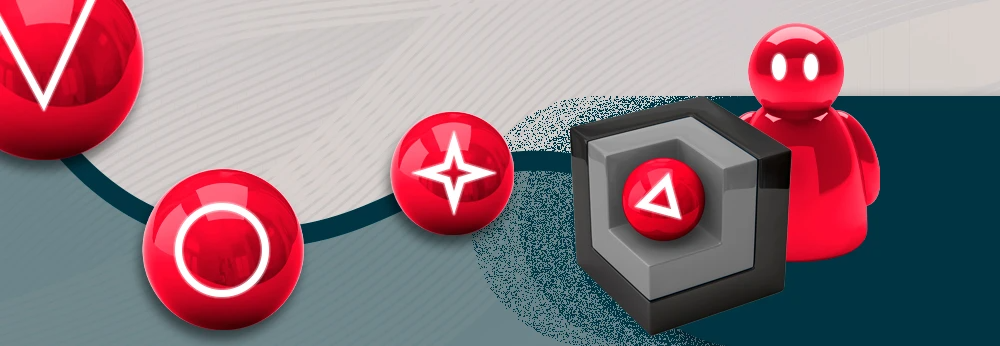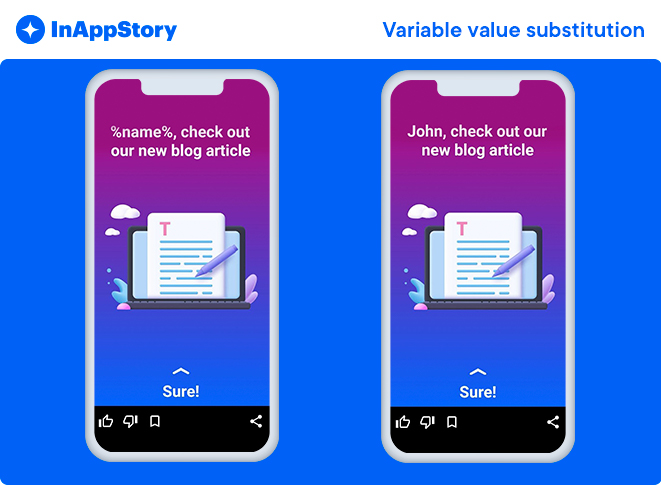.webp?2025-12-17T15:00:29.367Z)
Spotify Wrapped ideas make stats lovable

Why Businesses Need Mobile App Personalization of Stories
Sofiia Kuzmina
Author @ InAppStory
A user’s behavior in an app or on a website is determined by many external factors: financial situation, interests, age, and sometimes even the user’s device and where the user is at the moment. In the era of big data, all this information can be collected, analyzed and used to increase conversions by dividing customers into groups with similar parameters and generating specialized content for each of them. This is called user segmentation. And if you include an individual's name and an individualized offer to the message, the content will become personalized.
First, let's differentiate personalization from segmentation. Personalization is about getting a deeper understanding of customers within the groups indicated in the segmentation and developing an individual approach to each of them.
According to Accenture, 91% of users are more likely to buy products and services from brands that use personalization. 83% of them are ready to provide companies with all the necessary external data about themselves in order to receive more accurate recommendations and relevant offers. This means that the refusal of a brand to engage in personalization can be perceived as deliberately throwing away profits.
Why do you need personalization in mobile app Stories?
It doesn't matter whether it’s a Story, a lifestyle, or a mini-game that sells, or how well-written and expertly designed the content is. Most likely, only a certain audience will really appreciate it. For example, users from Boston are unlikely to benefit from a compilation of New York restaurant reviews, and people over 50 are likely to ignore a contest if the main prize is a ticket to a rap concert.
You can increase user engagement and customer satisfaction in your app by segmenting customers into general groups with minimal customization of content for each of them. In the 1+1 console, this is quite easy to do using the functionality of tags and variables.
How to use tags in the InAppStory console
As an example, consider the app of a tour operator that sells tour packages, plane tickets, and hotel rooms. Guided by general parameters, the target audience of such an app can be divided into several groups. Accordingly, each customer group can be assigned its own tag based on its characteristic feature.

In our example, average and hypothetical categories are given; in your case they may be different. The most common factors for mobile app user segmentation are:
- Behavioral – What needs of the user have to be satisfied, and how the customer is using the product. In the example with the tour operator's app, if the customer is more often interested in tours to Germany, these should be offered to them first. This factor primarily affects the interests of the specific user and allows them to form a list of goods and services that they need at the moment, which they are less likely to ignore.
- Geographic – The country, region, city, or district where the user lives. This is a key factor for any business operating in multiple cities or even countries. This segmentation allows you to tailor the offering of goods and services for a specific location.
- Demographic – Age, gender, nationality. The needs of young people and adolescents differ from those of a more mature audience. Relatively speaking, it is unlikely that a 24-year-old salesperson will choose a vacation in a health resort in Kislovodsk instead of fashionable options for camping or a hotel on the shore of the Mediterranean Sea. Likewise, the choice is influenced by the gender and nationality of the customer. Knowing these factors, you can nudge each type of user to buy.
- Psychographic – A psychological portrait of the user and the lifestyle the user is accustomed to. In order to interest the user and keep their attention, it is better to communicate in a language they understand. If the target audience of your app is heterogeneous in terms of this factor, it is more convenient to divide it into several groups and develop an individual own approach for each.
By configuring your app to collect this kind of user information and pass that information to an SDK, you can create the same tags in the InAppStory console. Tags assigned to a particular Story will determine the user to whom it will be shown.
Tutorial on how to create tags in the InAppStory console: https://youtu.be/seGowtF5wRM?list=PLsoNSi5Y3DHMCS7ryMN7lbGSM8BllGuTp
Stories for different groups of users can differ not only by the subject matter. For example, a Story for young people can be designed in a brighter, more modern or provocative style than for an older audience. The style of the texts can also differ: in order to establish a trusting relationship with users, it’s worth talking to them in the manner they’re used to. Younger users are more likely to appreciate interactive content such as videos and mini-games, while older users are more likely to appreciate more complex formats such as quizzes or long-text Stories.
Also, by dividing the audience of in-app Stories into customer segments, you can study the statistics more thoroughly and understand which Stories resonate with a particular group.
If several tags are assigned to a certain Story in the InAppStory console, then it will be seen by all users to whom at least one of them is assigned. That is, if a Story is tagged "New York" and "Young," then it will be seen by users who are assigned either the first or the second tags, i.e. those who are in the capital and those who are 18-25 years old.
In the console, when adding tags to a Story, this can be configured by so-called operators. These are small text commands that you can use when listing tags. There are three operators in total:
- OR – used in the example above
- ! (exception)
- AND (addition)
If you write the ! operator before the tag, for example, "! New York," then such a Story will be seen by all users, except for those who have been assigned this tag. In order for Stories with the tags "New York" and "Young" to be seen only by users falling under both categories, you need to write the AND operator between them.
Use tags to segment app users and post Stories tailored to the needs of the highlighted groups. For example:
- If your product is suitable for a wide target audience, but the content needs to be adapted for different groups of customers, e.g., thematically, stylistically or by design.
- If you run promotions with a limited number of participants, for example regional, or you want to offer goods or services to a certain group of customers, for example users with high income or retirees.
- If you plan to adapt interactive content (quizzes, games, videos) for different types of users.
Another personalization tool: Variables
In the console, this is the name for formulas that can be inserted into the text of a Story and which will be displayed differently for each user (or group). For example, using variables, you can refer to a user by name, or provide them with personal statistics or a unique promotional code. The task of this tool is similar to the task of tags: it is used to close the distance between you and the user. However, variables are a more versatile tool that can be used to customize content that is already split into user groups.
It is scientifically proven that our brains become more focused when we are addressed by our first name. Imagine that your app has knowledge of usernames and passes this knowledge to your SDK for publishing Stories. Instead of making separate tags for each name and releasing many in-app Stories with a one-word difference, you can use the %name% variable in the text. Then, for each user who opens the Story, this variable will be automatically replaced by their name.

This way, you can display any information that is important to you and that is available in the app in the form of variables. In the "Settings" section, from the "Variables" tab, you can add a new variable or edit the existing list in the console.

You will first need to configure the unloading of variables with the same name in the app SDK.
Use variables to address the user directly and make the Story even more personalized. For example:
- If you want to address the customer by name in the Story.
- If your app collects data that you would like to share with users, e.g., the product that the customer bought most often, how many hours the user spent in your app, etc.
- If your goal is to close the distance between the brand and your customers through more personal communication.
Personalized Stories are a powerful tool for promotion
The InAppStory console uses tags, operators, and variables to quickly set up and apply personalized Story delivery. Divide your audience into small groups using tags, fine-tune the display of Stories from different users with the help of operators, and customize Stories using variables to increase app conversion rate and engagement. After the first Stories are published, you will have detailed statistics that will help you understand what content is better for your customers. This means you will quickly satisfy their needs and increase their loyalty.
Want to write for us? Check this

